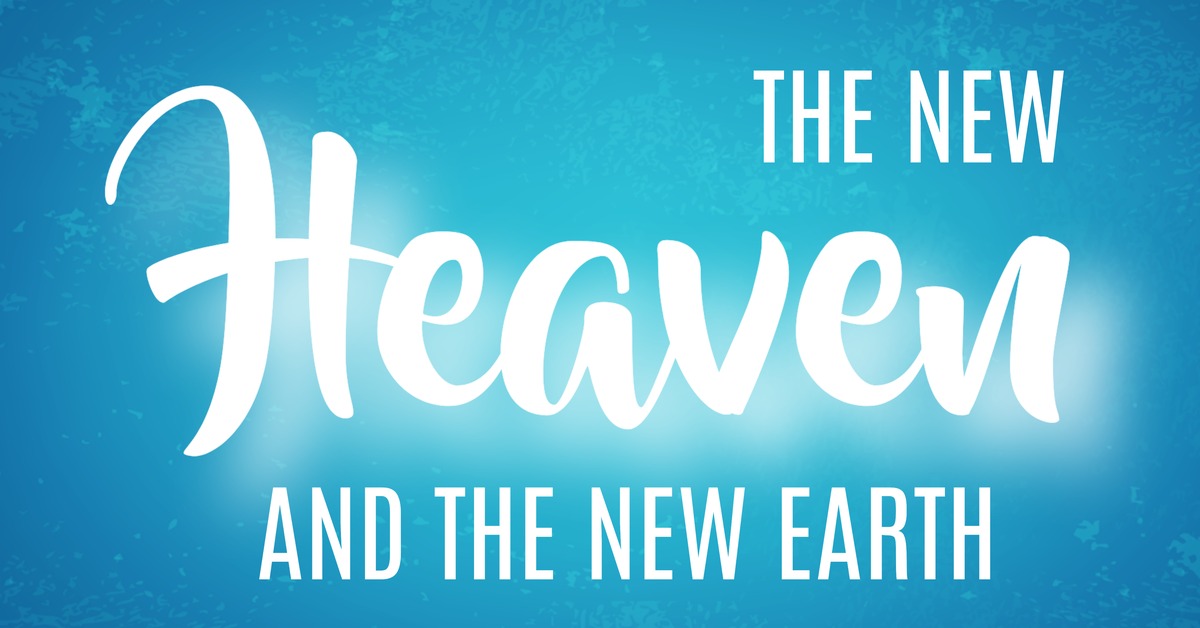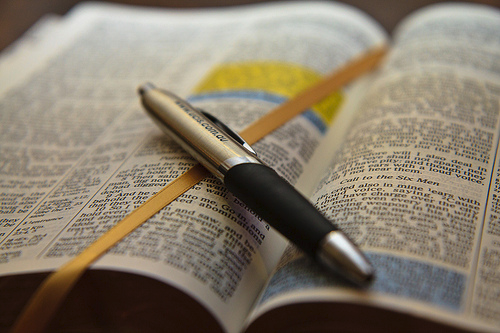Then I saw a new heaven and a new earth, for the first heaven and the first earth had passed away, and the sea was no more. And I saw the holy city, new Jerusalem, coming down out of heaven from God, prepared as a bride adorned for her husband. And I heard a loud voice from the throne saying, “Behold, the dwelling place of God is with man. He will dwell with them, and they will be his people, and God himself will be with them as their God. 4 He will wipe away every tear from their eyes, and death shall be no more, neither shall there be mourning, nor crying, nor pain anymore, for the former things have passed away.”
And he who was seated on the throne said, “Behold, I am making all things new.” Also he said, “Write this down, for these words are trustworthy and true.” And he said to me, “It is done! I am the Alpha and the Omega, the beginning and the end. To the thirsty I will give from the spring of the water of life without payment. The one who conquers will have this heritage, and I will be his God and he will be my son. But as for the cowardly, the faithless, the detestable, as for murderers, the sexually immoral, sorcerers, idolaters, and all liars, their portion will be in the lake that burns with fire and sulfur, which is the second death.”
Then came one of the seven angels who had the seven bowls full of the seven last plagues and spoke to me, saying, “Come, I will show you the Bride, the wife of the Lamb.” And he carried me away in the Spirit to a great, high mountain, and showed me the holy city Jerusalem coming down out of heaven from God, having the glory of God, its radiance like a most rare jewel, like a jasper, clear as crystal. It had a great, high wall, with twelve gates, and at the gates twelve angels, and on the gates the names of the twelve tribes of the sons of Israel were inscribed— on the east three gates, on the north three gates, on the south three gates, and on the west three gates. And the wall of the city had twelve foundations, and on them were the twelve names of the twelve apostles of the Lamb.
And the one who spoke with me had a measuring rod of gold to measure the city and its gates and walls. The city lies foursquare, its length the same as its width. And he measured the city with his rod, 12,000 stadia. Its length and width and height are equal. He also measured its wall, 144 cubits by human measurement, which is also an angel’s measurement. The wall was built of jasper, while the city was pure gold, like clear glass. The foundations of the wall of the city were adorned with every kind of jewel. The first was jasper, the second sapphire, the third agate, the fourth emerald, the fifth onyx, the sixth carnelian, the seventh chrysolite, the eighth beryl, the ninth topaz, the tenth chrysoprase, the eleventh jacinth, the twelfth amethyst. And the twelve gates were twelve pearls, each of the gates made of a single pearl, and the street of the city was pure gold, like transparent glass.
And I saw no temple in the city, for its temple is the Lord God the Almighty and the Lamb. And the city has no need of sun or moon to shine on it, for the glory of God gives it light, and its lamp is the Lamb. By its light will the nations walk, and the kings of the earth will bring their glory into it, and its gates will never be shut by day—and there will be no night there. They will bring into it the glory and the honor of the nations. But nothing unclean will ever enter it, nor anyone who does what is detestable or false, but only those who are written in the Lamb’s book of life.
Understanding And Applying the Text
This is John’s last vision. It is the consummation of all that has gone before. There are a new heaven and a new earth. There is a new Jerusalem. This contrasts with the harlot city. The first 8 verses summarize what John is about to see.
The old is gone God has replaced the heavens above and the earth beneath. There is no more sea. To Israel, the sea represented turmoil, unsteadiness, and chaos. In the new heaven and new earth all that is gone. God dwells with men.
Throughout the book, we have seen a contrast between heaven and earth. Those who are in heaven are the saved. Those on earth are the lost. Heaven is we find where God, the angels, and the redeemed. Earth is the dwelling of the dragon and harlot city.
That has been the story of redemptive history. Ever since the fall, there has been a separation between heaven and earth. But now the new Jerusalem comes down from heaven. There is no more separation between heaven and earth. God dwells with man.
God has judged the wicked. But for the redeemed there is goodness. Heaven comes down. Evil and pain are gone. There is a new creation. This is a stark contrast to the pain, suffering, and struggles that run in earlier parts of Revelation. God fulfills His promises to the overcomers.
Is the new Jerusalem terrestrial? Or is it in heaven? The description sounds like it could be either. Paul talks about the Jerusalem above. (Galatians 4:26) The writer to the Hebrews tells of a heavenly Jerusalem. (Hebrews 12:22)
In either case, God is dwelling with man as he did in the garden. The new earth and the new Jerusalem sound so glorious because God is there. God has remade both heaven and earth. We start anew.
There are those who claim the new heaven and new earth fit within the timeline end of the age. That is the end of the Jewish age. That is a mistake.
Some have thought the new heaven and new earth indicate a new universe. It has no connection with the old. This is an erroneous conclusion. Several verses show the earth is eternal, (Ecclesiastes 1:4; Psalms 78:69; 104:5.) One could argue these are poetic ways of saying it lasts a very long time. But Isaiah 65:17-25 and Romans 8:21-23 indicate a continuity. In the same way, our new bodies will have continuity to the old (1 Corinthians 15:35-37). The fact everything is new (v. 5), implies a complete and thorough transfiguration. The caterpillar transforms into a butterfly. And there is a continuity between the two.
Verse 9 opens the same way as the vision of the harlot. One of the seven angels who had the vials told John he would show him the Lamb’s bride.
The vision unfolds a picture of the New Jerusalem. This is the final dwelling place of saints. It fulfills earlier revelations of God appearing in glory and reigning. God reigns in His heavenly court. (21:2223 ;22:1,3 cf. Chapter 4) He reigns in the holy city Jerusalem (21:10). This recalls His reign in the Garden. (22:1-3). The central figure and the central blessing of the city is God Himself and the Lamb (21:22,23 22:1-5). This final revelation brings to a climax all the earlier revelations. It completes God’s purpose. It brings everything under one Head—Christ (11:15; Ephesians 1:10). It harmonizes with Christ’s creation of everything at the beginning (1:17; 4:11; Colossians 1:15-17). It redeems everything through Christ. (5:9–14; Romans 11:36; Colossians 1:18-20) .
I make no attempt to enter into a detailed explanation of the symbols. Such an attempt is both presumptuous and folly. The new Jerusalem at times represents a city and a woman. This is the same double-figure employed in the description of the harlot. In this vision, the figure of the bride is dropped almost as soon as it is introduced. The rest of the description is about the architecture, the wealth, splendor, and glory of the city. Some of the features come from the city seen by Ezekiel. But there is one major difference. Ezekiel describes the temple in elaborate detail. It occupies the principal part of Ezekiel’s vision. Here there is no temple.
The angel takes John to a mountain. This is very symbolic. The mountain was God’s special meeting place. He met other men on Mountains. (14:1; Exodus. 15:17; 19:1–25; Psalms. 48:1, 2; 68:15, 16; Ezekiel. 28:14; Miciah. 4:1, 2)
There is no sun. There is no need. God’s glory illuminates everything everywhere. God’s glory is associated with the imagery of light. Glory represents the majesty, awesomeness, and beauty of God. Glory is a prominent theme in the vision It is the appearing of God in the Old Testament (Ex. 16:10; 24:16, 17; 40:34, 35; Is. 6:3; 40:3; 60:1, 2, 19, 20; Hab. 2:14; Zech. 2:5; John 1:14). God’s heavenly splendor fills the new world.
The city is a perfect cube. That is the same shape as the Most Holy Place in the tabernacle and the temple. The whole city is architecturally perfect.
The list of precious stones shows the beauty and magnificence of the city. It reflects God’s beauty. God fills it with His glory. There is a rough correspondence between the stones and the twelve precious stones of Aaron’s breastplate (Exodus. 28:15–21).


Leave a Reply